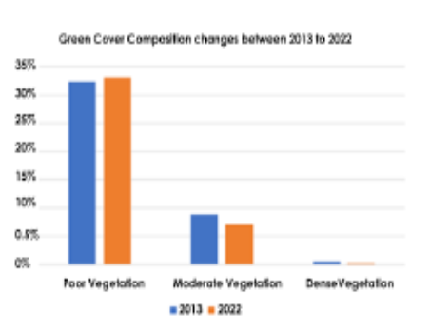


Indian Journal of Science and Technology
Year: 2024, Volume: 17, Issue: 2, Pages: 134-141
Original Article
S Joy Gloria1, Shanmuga Priya Gnanasekaran2*
1M. Arch Student, Department of Architecture, School of Planning and Architecture, Vijayawada, 520008, Andhra Pradesh, India
2Associate Professor, Department of Architecture, School of Planning and Architecture, Vijayawada, 520008, Andhra Pradesh, India
*Corresponding Author
Email: [email protected]
Received Date:15 May 2023, Accepted Date:11 December 2023, Published Date:12 January 2024
Urban vegetation and green cover provide the urban environments with many ecosystem services and are effective in mitigating the Urban Heat Island (UHI) effect. UHIs are formed in areas with increased Land Surface Temperatures (LST) and have various negative impacts on the thermal environment. Objective: This study aims to analyse how the urban vegetation and green cover play a key role in decreasing the LST in a selected city i.e., Chennai Metropolitan Area (CMA) and develop strategies for the mitigation of UHI. Methods: The relationship between the LST and urban vegetation cover is analysed for the CMA. The study applies remote sensing and LANDSAT 8 data to study the Normalized Difference Vegetation Index (NDVI), LST and green cover loss for the summer months of 2013 and 2022. Findings: Change detection of NDVI and LST in CMA shows a decrease of green cover by 13.33% and an increase of LST by 6.53°C between 2013 and 2022. The study reveals a weak UHI effect in regions with vegetation and a substantial negative association between the LST and NDVI. The study findings show a reduced quality of green cover in CMA which requires further attention. Novelty: This study covers the assessment of vegetation loss and its impact on LST in the recent decade bridging the gap in the studies in the extended metropolitan region of Chennai. Strategies that can be incorporated in the urban and landscape design and planning process to improve the urban vegetation of CMA are indicated in the study.
Keywords: Urban Vegetation, Urban Heat Island, Green Cover, Change Detection, UHI Mitigation Strategies
© 2024 Gloria & Gnanasekaran. This is an open-access article distributed under the terms of the Creative Commons Attribution License, which permits unrestricted use, distribution, and reproduction in any medium, provided the original author and source are credited. Published By Indian Society for Education and Environment (iSee)
Subscribe now for latest articles and news.